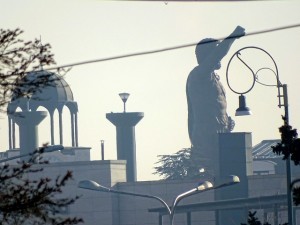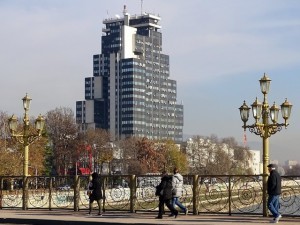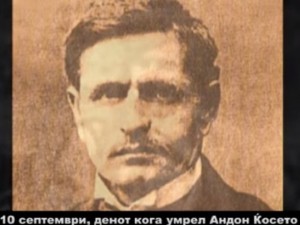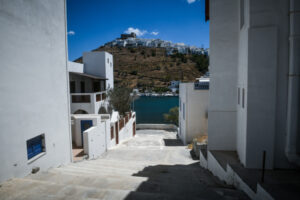Former Yugoslav Republic of Macedonia (FYROM) public broadcaster, “Macedonian” Radio and Television, MRTV, spent 1,8 million Euros over three years producing documentaries reflecting the ideological idées fixes of the former ruling right-wing VMRO DPMNE party, BIRN analysis of the production deals made in 2013, 2014 and 2015 shows.
MRTV’s legal duty to cooperate with independent production houses in producing documentaries was used for the mass production of historic documentaries that – like the government-sponsored faux-baroque revamp of the capital, Skopje 2014 – were intended to revise the nation’s understanding of the past.
This was to be done from the viewpoint of “a biblical nation” that drew continuity from the Classical era of Alexander the Great, through the era of Byzantine era missionaries, all the way to the Anti-Fascist fight during World War II and the declaration of independence in the early 1990s.
As with the architectural principles behind Skopje 2014, these documentaries were heavily mentored by the former government of Nikola Gruevski, which was ousted this May after 11 years in power.
This aim becomes apparent, among other things, from some of the wiretapped conversations released by the opposition back in 2015.
In one conversation between Gruevski and his transport minister, Mile Janakieski, the then Prime Minister says he wants half a million euros for the budget of the Electronic Communications Agencies, which he says is what the government “owes for documentaries”.
“Let’s say he transfers [money] for ‘social responsibility’…we can name some documentary which is, let’s say, the most popular, which most suits, for example, the ‘Macedonian’ struggle for freedom and independence,” Gruevski is heard telling Janakieski, regarding the finances for the documentaries.
The money “will be used for all the documentaries, but let him say [that it will be used] only for this [one purpose], not for Skopje or for something else, you know. Let it be for the ‘Macedonian’ struggle,” Gruevski further instructs.
Bringing back “forbidden” history
The documentary dedicated to Skopje 2014, whose working title was “Skopje Moves On”, was one of the cheapest joint productions of MRTV.
It cost the public broadcaster only 7,000 euros for 14 episodes. But the ideological trajectory of the entire series, reflecting the idea that “Remembrance was forbidden in ‘Macedonia’, and beauty was forbidden in Skopje”, is evident from the first episode.
“For you, who lived 30 years without seeing a single new building in the center of Skopje, who were born in independent ‘Macedonia’ and wonder why it is forbidden in your country to remember and have history, it is time, time to get what is ours,” the documentary says.
The main interlocutors included in this series were the then Prime Minister, Gruevski, his Culture Minister, Elizabeta Kanceska-Milevska, the former VMRO DPMNE mayor of Skopje’s Centar municipality, Vladimir Todorovic, various artists and historians, the pro-government show host, Milenko Nedelkovski, and just one critic of Skopje 2014, the architecture professor Miroslav Grcev.
The connection between the construction project in Skopje and the documentary project is also evident from the way the erection of new monuments was synchronized with the release of new documentaries about the dignitaries being commemorated.
The statues of Andon Lazov Janev–Kjoseto, an Ottoman-era revolutionary who remains controversial due to his assassinations of other prominent revolutionaries who were painted as “traitors”, of Lydia from “Macedonia”, of the World War II hero Mihajlo Apostolski and of another Ottoman-era revolutionary, Gjorgi Sugarev, all erected as part of the last batch of statues in 2015, were complemented with documentaries filmed that same year.
This TV series strove to achieve at least some balance when it came to the country’s large ethnic Albanian community, filming a single documentary dedicated to the Albanian hero Skender Bey also known as Skanderbeg or with his Greek name Georgios Kastriotis.
Historical movies repeated endlessly
The documentaries produced as part of this project were aired and replayed frequently by the national broadcaster, and later by other TV stations seen as close to the then ruling VMRO DPMNE party.
Some of the documentaries were replayed three or four times during the same day following their premiere.
Such was the example with the series “20 years of ‘Macedonian’ Independence”, which was aired three more times the same day after its premiere in 2011.
“Having in mind that each episode is roughly one hour long, it turns out that four hours were dedicated each day only to air episodes of this series,” the Agency on Media noted in its analysis of the MRTV programs released in October 2011, suggesting that “this banalization by multiple reprises during the same day should stop”.
(Macedonian Radio and Television filmed documentaries about Alexander the Great, Philip of Macedon and Aminta the Third)
After MRTV in 2014 granted rights to other private TVs to air the same documentaries, they followed the same pattern of constant replays.
Once aired on prime time, these days these documentaries can only be seen on Kanal 5 Plus TV and sporadically on Sitel 3, where they mainly serve as programmer fillers.
Some 70 documentaries produced over three years
Documents from signed contracts that BIRN has obtained show that during 2013, 2014 and 2015, MRTV spent a total of 1.8 million euros on producing such historic documentaries. The peak year for production was 2013.
Over these three years, some 70 documentaries or series dedicated to historical figures or events were produced.
Among them are documentaries whose working titles were “Alexander the Great”, “Philip The Second (With Aminta the Third)”, “St Cyril and Methodius” and “St Clement and Naum”.
The lives and contributions of the “Macedonian” revolutionaries Dame Gruev, Goce Delcev, Boris Sarafov, Pere Tosev, Koco Racin, and of some lesser-known figures, such as Gjorgi Bazdarov, Naum Tomaleski, Apostol Petkov Terziev and Petar Sandanov, were also commemorated in film.
The portrayals of the revolutionaries carried an average price tag of some 11.800 thousand euros each and each was aired on MRTV’s Channel 1. Nowadays, most of them can be seen only on unofficial channels on YouTube.
The documentary series were more expensive, costing anywhere from 20.000 to 100.000 euros each.
They mainly focused on historical topics like “Serbia’s Occupation of ‘Macedonia’”, “The Participation of Bulgarian and Other External Representatives in the ‘Macedonian’ National Organizations”, “The Historical Background and Greece’s Opposition to ‘Macedonia’’s Name, Language and Nation”, “Suicide as an Act of Sacrifice Among the ‘Macedonian’ Revolutionary Movement”, “’Macedonian’ Leaders During Communism,” and others.
The influence of the political views of the former ruling party in some of the produced documentaries can also be seen through the topics they treated.
For example, the documentary “Lustration in ‘Macedonia’, Between Past and Present” deals with the controversial subject of rooting out former Yugoslav spies from FYROM society.
One of the authors of this documentary was Tome Adziev, head of the now defunct Lustration Commission, which was installed by the past government despite many complaints that it was used mainly for political retaliation against the government’s critics.
Authors linked to Gruevski government
The private production houses that were chosen as co-producers for the documentaries mainly hired authors from the ranks of historians.
Apart from their expertise, one key factor for choosing the authors seems to have been their closeness to the ruling party or its values.
The most frequent author of texts was the recently deceased historian Zoran Todorovski, who then headed the National Archive.
Todorovski was linked to the Skopje 2014 revamp as well, which was made clear from his regular participation in the commissions that decided on the proposed looks of many of the statues that were erected in 2013 as part of the government-sponsored project.
Another frequent author is Mihajlo Minovski, a historian who this year, like the now opposition VMRO DPMNE, condemned the new government for signing a friendship agreement with Bulgaria, insisting that it was harmful to FYROM’s national interests.
Historian Nikola Zezov, another frequent author, shared the same criticism of the agreement signed by the new government led by the Social Democrats.
Zezov was also a loud critic of the so-called Colorful Revolution, a protest movement against Gruevski’s regime that appeared in 2016 and used paintballs to mark the newly built monuments and facades that it felt symbolized the regime. Zezov insisted that these were acts of desecration.
He also defended the former government over the whole documentary project, saying that the government of Gruevski had “made a huge undertaking, which will be hard to repeat any time soon”.
Source: balkaninsight.com
Ask me anything
Explore related questions








